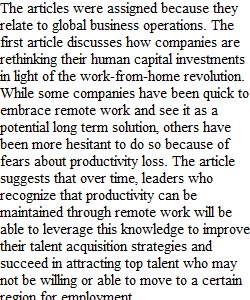


Q • Agrawal, S. et al. 2020. To emerge stronger from the COVID-19 crisis, companies should start reskilling their workforces now. McKinsey & Company, May: 1-7. • Bick, R. et al. 2020. A Blueprint for Remote Working: Lessons from China. McKinsey Digital, March: 1-8. • Kshirsagar, A. et al. 2020. Adapting workplace learning in the time of Coronavirus. McKinsey & Company,March: 1-6. Why do you believe the articles were assigned? Briefly introduce the underlying topic of the articles and demonstrate how this topic relates to international business operations and why the topic is relevant to understanding informal institutions
Q What are the key points of each article? Briefly (1-2 paragraphs each) discuss the key points of each article How do the two articles relate to each other and to textbook chapter 3? Draw a link between the two articles and the textbook chapter by carving out the key similarities, and the key differences across these article/chapter readings.What is the collective take-away from reading the two articles and textbook chapter 3? Briefly and concisely discuss what you believe are the 2-3 most valuable information you have learned from reading the two articles and textbook chapter 3.
View Related Questions